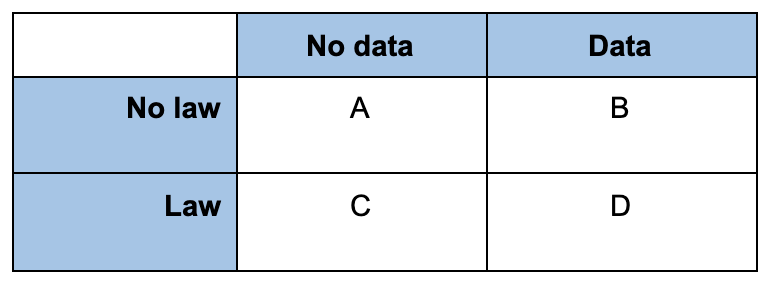Linking laws and data
In a number of the thematic modules of the Global Data Barometer we are looking to create paired indicators on the governance and availability of particular datasets. During a recent ‘Knowledge Storm’ session with our partners at the Open Government Partnership, Peter Varga (Senior Regional Coordinator for Europe at the OGP) offered a wonderfully concise summary of why this matters though the following matrix:

Take any given source of data that could be used for the public good. In any country there might be four broad scenarios to consider:
- A. No law, No data – there is no legal framework to support provision of the collection or provision of data, and no data is available.
- B. No law, Data – although there is no legal framework to specifically ground it, data is being produced and published.
- C. Law, no data – there is a legal framework for collection and/or publication of data, but in practice the data is not available, shared or open.
- D. Law, Data – there is a legal framework and the data is available.
There are nuances to each scenario. A law can have loopholes, or only support collection of documents rather than data. A dataset can be published, but lack the quality and coverage that it should have by law. Alternatively, there may be robust frameworks that guarantee the production and sharing of particular data without that taking the form of primary legislation. These complexities noted, understanding which quadrant a country falls into for any given kind of data can offer an important guide towards the priority areas for reform.
Over the coming weeks we are working on ways to streamline the process Barometer researchers will go through in order to rapidly assess the (legal) frameworks for data production in different thematic areas without taking on the overwhelming task of a full review of national laws. We’re hoping that in many cases we’ll be able to build on prior assessments, and, in a good number of cases to get to robust paired indicators.
